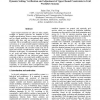Free Online Productivity Tools
i2Speak
i2Symbol
i2OCR
iTex2Img
iWeb2Print
iWeb2Shot
i2Type
iPdf2Split
iPdf2Merge
i2Bopomofo
i2Arabic
i2Style
i2Image
i2PDF
iLatex2Rtf
Sci2ools
SKG
2006
IEEE
2006
IEEE
Dynamic Setting, Verification and Adjustment of Upper Bound Constraints in Grid Workflow Systems
Upper bound constraints are often set when complex scientific or business processes are modelled as grid workflow specifications. However, many existing processes such as climate modelling or international stock market analysis often have only one end-to-end upper bound constraint. This is not sufficient to control overall temporal correctness as we may not find temporal violations until the last activity. Then, it is too late to take any handling actions. Consequently, the execution results may not be useful and overall cost-effectiveness would be impacted. Therefore, in this paper, we systematically investigate how to set, verify and adjust sub-upper bound constraints within the timeframe of one end-to-end upper bound constraint so that we can control grid workflow execution locally. We develop corresponding setting, verification and adjustment methods and algorithms. The quantitative evaluation demonstrates that with sub-upper bound constraints, we can achieve better cost-effective...
Distributed And Parallel Computing | End-to-end Upper Bound | SKG 2006 | Sub-upper Bound Constraints | Upper Bound Constraint |
| Added | 12 Jun 2010 |
| Updated | 12 Jun 2010 |
| Type | Conference |
| Year | 2006 |
| Where | SKG |
| Authors | Jinjun Chen, Yun Yang |
Comments (0)

